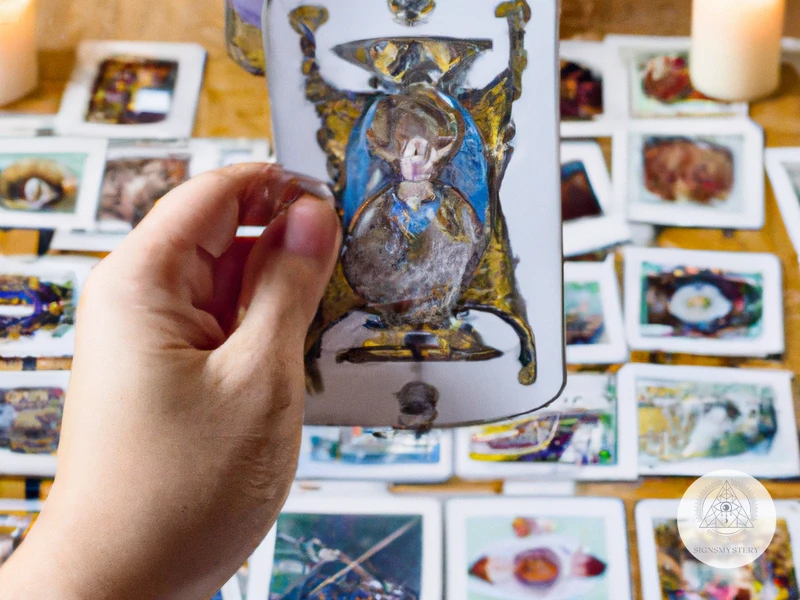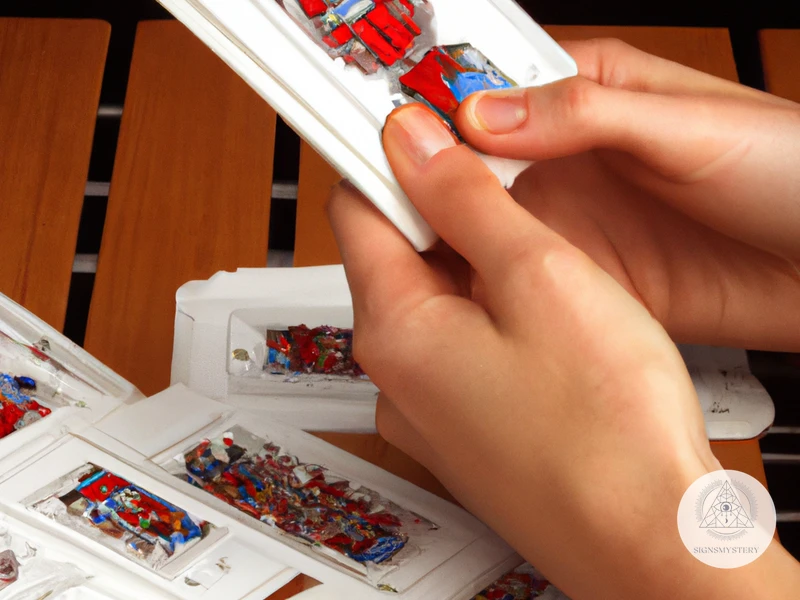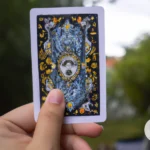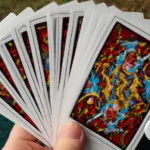As the art of tarot reading continues to gain popularity and mystique, more and more people are seeking to develop their own unique ways of working with the cards. One rewarding and creative approach is to craft your own tarot spread, tailored to your individual needs and intentions. But where to begin? With so many possibilities and options, the process can seem daunting. In this guide, we’ll navigate the steps of creating a personalized tarot spread, from determining your purpose to refining your final creation. Whether you’re a seasoned reader or a curious beginner, this journey promises to unlock new insights and connections with the cards. So let’s dive in and explore the art of designing your own tarot spread.
Step 1: Determine Your Purpose

When creating your own tarot spread, the first and most important step is to determine its purpose. This will help guide you in choosing card positions, crafting questions, and laying out the spread. Are you looking for relationship guidance? Career advice? Insight into your shadow self? Perhaps you want to explore past lives or uncover your life purpose. Defining your purpose will bring clarity and intention to your tarot practice. If you need inspiration, check out our article on top 10 spreads for relationship guidance, tarot spreads for career guidance, or tarot spreads for uncovering your life purpose.
What do you want to achieve with your tarot spread?
When creating your own tarot spread, it is essential to determine what you want to achieve with it. This will provide you with a purpose and direction for your spread. Here are a few questions to ask yourself to help determine your tarot spread’s purpose:
- What issues or questions do you want to explore? Perhaps you want to gain insight into a particular situation or relationship, or maybe you’re seeking guidance on a specific decision or problem.
- What tone do you want to set for the reading? Do you want the spread to provide comfort and reassurance, or do you want it to challenge you and encourage growth?
- What is the intended outcome of the reading? Do you want to gain clarity, achieve a specific goal, or gain a deeper understanding of yourself?
- Who is the target audience for your spread? Is the spread for personal use, or are you creating it for others to use as well?
- What is the significance of the spread? Does it relate to a particular tradition or theme, such as the Celtic Cross spread or Tarot Manifestation for Abundance? Or is it a more general spread designed to explore various aspects of the querent’s life, such as the Tarot Shadow Self spread or Past Life Tarot spreads?
- What scope do you want the reading to cover? Do you want to focus on a single question or issue, or do you want to explore multiple areas of the querent’s life, such as the decisions making tarot spreads?
- What type of information do you want to gain from the reading? Do you want the spread to provide practical advice, or are you seeking a more esoteric or spiritual understanding of the situation?
- What emotions or themes do you want the spread to evoke? Do you want to explore love or career, or perhaps the querent’s past, present or future? Do you want the spread to be uplifting or challenging?
Answering these questions will help determine the goals and purpose of your tarot spread. Once you have established this, you can move on to selecting card positions, crafting questions and laying out the spread in a way that best supports the intended outcomes.
Who is your target audience?
When creating your own tarot spread, it is important to consider the target audience for your reading. Understanding your audience is key to crafting a spread that resonates with them and meets their needs. To help with this step, consider creating an audience profile that outlines the characteristics of the individuals you will be reading for.
| Target Audience | Profile Description |
|---|---|
| Beginners | Individuals who are new to tarot and may be overwhelmed by more complex spreads. They may be seeking guidance on basic tarot concepts and how to interpret the cards. |
| Intermediate/Advanced | Individuals who have experience with tarot and may be seeking guidance on specific issues or areas of their life. They may be interested in exploring more complex spreads and interpretations. |
| General Audience | Individuals from a variety of backgrounds and experience levels. A spread that is accessible and easy to understand, but still provides meaningful insight, may be best suited for this audience. |
| Self-Exploration | Individuals who are seeking personal growth and self-reflection. A spread that encourages introspection and self-awareness would be well-suited for this audience. |
By identifying different target audiences, you can tailor your tarot spread to their particular needs and preferences. For example, a spread designed for beginners may have fewer card positions and simpler, more straightforward questions. In contrast, a spread for advanced practitioners may have more complex card placements and open-ended questions that require deeper reflection and interpretation.
Ultimately, knowing your audience can help you create a tarot spread that resonates with them and provides valuable insights and guidance.
Consider the scope of the reading
When creating your own tarot spread, it’s important to consider the scope of the reading. This refers to the overall purpose and focus of the spread, as well as the extent to which it will delve into specific topics or questions. Here are some factors to consider:
The level of detail:
Think about whether you want your tarot spread to provide a general overview or explore specific details. For example, a spread that focuses on a single question or issue will likely have fewer card positions than one that aims to give a comprehensive analysis of a complex situation.
The time frame:
Consider whether your tarot spread will be focused on the past, present, future, or a combination of these time frames. Depending on the context of the reading, you may want to adjust the card positions or questions to reflect a more immediate or long-term focus.
The thematic scope:
Think about the topics or themes you want to explore in your tarot spread. Are you focusing on relationships, career, personal growth, or something else? The scope of the reading should align with your overall purpose and target audience.
The level of introspection:
Consider how deep you want to go with your tarot spread. Will you be exploring surface-level issues or diving into deeper emotional or spiritual territory? This will affect the types of questions you create and the level of interpretation required.
By taking these factors into account, you can create a tarot spread that is well-suited to your needs and goals. Don’t be afraid to experiment with different scoping options and adjust as needed based on feedback and personal intuition. If you need help with interpreting your spread, check out our article on intuition tarot spread interpretation for guidance.
Step 2: Choose Your Card Positions
When it comes to creating your own tarot spread, choosing the right card positions is essential. The positions you choose will determine the flow and depth of the reading, as well as the specific insights and information that emerge. With so many possibilities to consider, it’s important to approach this step with thoughtful consideration and creativity. In this section, we’ll explore the key factors to keep in mind as you select the card positions for your unique tarot spread.
Start with a small number of positions
When it comes to creating your own tarot spread, it’s important to start with a small number of positions. This means that you shouldn’t overwhelm yourself or your querent with too many cards or complicated layouts.
To keep things simple, consider starting with a three-card spread. This is a classic layout that can be used for a variety of purposes, from past-present-future readings to body-mind-spirit inquiries.
Another option is to use a four-card spread, which is great for exploring a particular issue or decision. You can assign each card position to represent different aspects of the situation, such as pros, cons, advice, and overall outcome.
Of course, you can always adjust the number of positions to meet your needs, but keep in mind that more positions don’t necessarily equal a better reading. Instead, focus on honing in on a specific question or topic and using the cards to illuminate different perspectives or insights.
Here’s an example of a simple three-card spread:
| Position 1: | The present situation |
| Position 2: | The challenge or obstacle |
| Position 3: | The advice or outcome |
Remember, the key is to keep it simple and focused. Don’t be afraid to experiment and try out different variations, but always keep the querent’s needs and the purpose of the reading in mind.
Consider traditional card placements
When creating your own tarot spread, it’s important to consider traditional card placements. These positions have been established over time and are commonly used in tarot readings. Here are a few traditional positions to consider when designing your tarot spread:
- Present: This card represents the current situation or circumstances of the querent.
- Past: This card represents the past events, experiences, or influences that may have led to the present situation.
- Future: This card represents the potential outcome or direction of the situation.
- Obstacle: This card represents any challenges or obstacles that may need to be overcome in order to achieve the desired outcome.
- Advice: This card offers guidance or advice on how to approach the situation or navigate any obstacles.
- Outcome: This card represents the final result or outcome of the situation.
In addition to these traditional positions, you can also consider other common card placements such as “self”, “environment”, “hopes/fears”, and “external influences”. Remember to choose positions that align with your purpose and intended audience, and don’t be afraid to modify or add to these traditional positions to better suit your needs.
Allow for flexibility
When creating your own tarot spread, it’s important to keep in mind that flexibility is key. This means allowing room for interpretation, adaptability, and even improvisation. Here are some ways to incorporate flexibility into your tarot spread:
- Leave room for unexpected insights: Don’t box yourself in too much with preconceived notions of what each card position and question should mean. Leave space for unexpected insights and messages to come through in your reading.
- Be willing to adjust: If a certain card position or question isn’t working as intended, be willing to make adjustments on the fly. Your tarot spread should be a living, breathing thing that can evolve over time.
- Allow for multiple interpretations: Consider creating card positions that can be interpreted in several different ways, or phrasing questions that allow for multiple meanings. This can help prevent a reading from feeling too rigid or one-dimensional.
- Encourage creativity: Your tarot spread should be a reflection of your own unique perspective and style. Don’t be afraid to get creative and experiment with different layouts, card positions, and questions.
- Stay open to the unexpected: Tarot readings can often reveal unexpected insights or messages that don’t fit neatly into your preconceived ideas. Remain open to whatever comes up during the reading, and don’t be afraid to pivot or change directions if needed.
Remember, the beauty of tarot is in its ability to offer insights and guidance in a way that is personal and meaningful to you. By allowing for flexibility in your tarot spread, you can amplify this power and create a truly unique and transformative experience.
Step 3: Craft Your Questions

Now that you have determined the purpose of your tarot spread and chosen your card positions, it’s time to craft the questions that will guide the reading. This step is crucial in ensuring that the spread is meaningful and effective in delivering insights and guidance. By asking the right questions, you can help your querent gain clarity and insight into their situation. In this section, we will explore how to choose meaningful and open-ended questions, consider the card positions and overall theme, and keep the spread simple and focused. Let’s delve into the art of crafting tarot questions.
Choose meaningful and open-ended questions
When crafting the questions for your tarot spread, it is essential to choose meaningful and open-ended questions that allow for interpretation and contemplation. Open-ended questions are those that cannot be answered with a simple “yes” or “no” response, but require deeper thought and consideration. To help guide your questioning process, consider the following tips:
| Tip | Description |
|---|---|
| Reflect on your purpose | Think back to the purpose you identified in Step 1 and consider what types of questions will help you achieve that purpose. |
| Avoid leading questions | Leading questions are those that suggest a particular answer. Instead, ask open-ended questions that allow for a range of possible interpretations. |
| Stay focused | Avoid asking too many questions or straying too far from your main focus. Stick to a few core questions that address your main concerns. |
| Phrase questions carefully | Consider the phrasing of your questions carefully to ensure they are clear and easy to understand. Use straightforward language and avoid overly complex phrasing. |
| Allow for interpretation | Leave room for interpretation and reflection by asking questions that generate multiple possible meanings or outcomes. |
| Be mindful of bias | Avoid asking questions that are biased or loaded. For example, avoid questions that assume a particular outcome or place blame on a person or situation. |
By choosing meaningful and open-ended questions, you allow for deeper exploration of the issues at hand and invite intuitive interpretation of the card placements in your tarot spread. Remember, the questions you ask play a critical role in shaping the insight and guidance you can gain from your tarot reading.
Consider the card positions and overall theme
When creating your own tarot spread, it’s important to consider the relationship between the card positions and the overall theme of your spread. By doing so, you can ensure that your questions and card placements are aligned with your intended message.
Card Positions
First, think about the number and placement of the cards. Will you have a small number of positions, such as three or four, or a larger spread with ten or more cards? Each card position should serve a specific purpose in your spread, whether it’s representing a particular aspect of the situation or providing insight into a specific question. Consider using a mixture of major and minor arcana cards to provide depth and nuance to your reading.
Using an html table could be a great visual exploration of our part of the article:
| Card Positions | Considerations |
|---|---|
| Number of Positions | Will you have a small number of positions, such as three or four, or a larger spread with ten or more cards? |
| Placement of Cards | Each card position should serve a specific purpose in your spread, whether it’s representing a particular aspect of the situation or providing insight into a specific question. |
| Type of Cards | Consider using a mixture of major and minor arcana cards to provide depth and nuance to your reading. |
Overall Theme
Next, determine the overall theme of your spread. Are you focusing on love and relationships? Career and finances? Personal growth and development? By choosing a specific theme, you can guide your questions and ensure that your spread is focused and purposeful.
Once you have a theme, consider how each card position fits into the larger picture. Do the questions and positions flow logically, building upon each other to provide a cohesive message? Or are they disjointed and disconnected?
Using an html table could also help visualize this section:
| Overall Theme | Considerations |
|---|---|
| Specific Theme | Determine the overall theme of your spread so you can guide your questions and ensure that your spread is focused and purposeful. |
| Logical Flow | Consider how each card position fits into the larger picture. Do the questions and positions flow logically, building upon each other to provide a cohesive message? |
| Coherence | Ensure that the questions and card positions work together to convey a clear and meaningful message. |
By taking the time to carefully consider the card positions and overall theme of your spread, you can create a tarot reading that is both insightful and valuable. Remember to keep your questions open-ended and meaningful, and to stay flexible and open to intuition and creativity as you lay out your spread.
Keep it simple and focused
When crafting your questions for a tarot spread, it’s important to keep them simple and focused. If your questions are too complex or convoluted, it can be difficult for the cards to provide clear and concise answers. To ensure that your questions are effective, consider the following strategies:
| Strategy | Description |
|---|---|
| Be concise | Keep your questions short and to the point. This will help ensure that the cards are able to provide clear and focused answers. |
| Avoid double-barreled questions | Avoid asking questions that include multiple ideas or concepts. For example, instead of asking “What is the best way to approach my career and love life?”, try asking two separate questions that focus on each topic individually. |
| Avoid overly vague questions | Avoid questions that are too broad or general. For example, instead of asking “What does the future hold?”, try asking a more specific question that focuses on a particular area of your life. |
| Choose relevant questions | Choose questions that are relevant to your current situation or goals. This will help ensure that the answers you receive are useful and actionable. |
By keeping your questions simple and focused, you’ll be better able to interpret the answers provided by the cards. Remember to approach your tarot spread with an open mind and a willingness to learn, and you’ll be well on your way to developing a deeper understanding of yourself and your path forward.
Step 4: Lay Out Your Spread
Now that you have determined the purpose, selected card positions, and crafted meaningful questions for your tarot spread, it’s time to lay out your cards. This step requires careful consideration of the design and placement of your cards, as it can greatly impact the interpretation and flow of your reading. By taking into account symmetry, visual cues, and your own intuition, you can create a layout that enhances the overall theme and effectiveness of your tarot spread. Let’s explore some tips and techniques for laying out your tarot cards.
Consider symmetry and balance
As you lay out your tarot spread, it’s important to consider symmetry and balance. This will create a visually appealing layout that is also energetically balanced. One way to do this is by using an HTML table.
Create a table with an equal number of columns and rows. Use the same width and height for each cell to ensure uniformity. This will give your spread a sense of balance and harmony.
In each cell, place a card position and its corresponding question. Make sure to keep the questions open-ended and relevant to the overall theme of the spread.
As you fill in the table, consider how the questions and card positions work together. Is there a flow or logical sequence to the spread? Make sure that each card position supports the overall theme and purpose of the spread.
Once your table is complete, take a step back and look at the spread as a whole. Is it visually balanced and pleasing to the eye? Are there any areas that feel cluttered or overwhelming? If so, consider moving or removing some card positions to create a more harmonious layout.
Remember
Subscribe to Our Newsletter
Sign up to receive the latest news and updates.
By taking the time to consider symmetry and balance in your tarot spread, you’ll create a beautiful and harmonious layout that enhances the energy and effectiveness of your reading.
Use visual cues
Visual cues are an important aspect when it comes to creating a tarot spread. Using striking and visually appealing images can significantly enhance the experience of the reading. You can incorporate visual cues in your tarot spread in various ways.
One way to use visual cues is to create a table that visually represents the card positions. You can use HTML table tags to craft a visually appealing and organised layout. For instance, you may have a table with three rows and three columns for a 9-card spread. You can also play around with different color schemes to add further visual interest, for example, highlighting specific card positions or using contrasting colors.
Another way to incorporate visual cues is by selecting an overarching image or theme for your tarot spread. This will create a sense of unity and cohesiveness throughout the reading. You can use this theme to create a visual representation that ties together all the card positions. For instance, if your theme is related to the ocean, you can use images of waves, water, and sea creatures in your spread.
Additionally, you can use graphics or symbols for each card position to add more visual interest. These symbols can represent the meaning of the position or the card drawn in that position. For instance, you might use a sun symbol for a position that represents optimism and positivity, or a tree symbol for a position that represents growth and evolution.
Ultimately, incorporating visual cues in your tarot spread will enhance the aesthetic appeal and provide a more intuitive and pleasant reading experience. Remember to keep your layout balanced and visually pleasing, and to use contrasting colors and graphics wisely to communicate the intended meanings strongly.
Allow for intuition and creativity
In the process of crafting your tarot spread, it is important to allow for intuition and creativity. These elements can help add a personalized touch to your spread and make it unique to you. You may find that certain card positions or questions intuitively come to mind, and it’s important to trust that instinct and incorporate it into your spread.
One way to tap into your intuition and creativity is to experiment with different layouts and card positions. Don’t be afraid to try something new or unconventional. You may discover a layout that works perfectly for you but wouldn’t have been found using traditional methods.
Another way to allow for intuition and creativity is to incorporate visual elements into your spread. Perhaps you want to use a certain color scheme, or include relevant images or symbols on your spread. These visual cues can help you connect more deeply with the cards and enhance the overall experience of the reading.
It’s important to remember that your tarot spread is ultimately for your own personal use, and there are no hard and fast rules that must be followed. Trust yourself and your instincts, and allow your creativity to guide you in creating a spread that is uniquely yours.
Step 5: Practice and Refine
Now that you have created your own tarot spread, it’s time to put it into practice. While designing a tarot spread requires creativity and intuition, using it regularly will help you refine and adjust it to better suit your needs. In this final step, we will explore the importance of practice and refinement, as well as ways to experiment and improve your tarot spread over time. So grab your deck, shuffle your cards, and let’s dive in.
Use your own tarot spread regularly
In order to fully benefit from your newly created tarot spread, it is important to use it regularly. This means integrating it into your existing tarot practice, whether that includes daily draws or weekly readings. Using your own spread regularly can provide a deeper understanding of the positions and questions, and help strengthen your overall tarot skills.
Here are a few tips for using your spread regularly:
- Schedule regular readings: Block out time in your calendar to perform readings using your custom spread. This could be once a week, once a month, or any other interval that works for you.
- Keep a journal: Record your interpretations and impressions of each reading in a journal. This can help you track patterns and themes over time, and also allow you to reflect on your growth and progress.
- Experiment with different decks: Try using your custom spread with different tarot decks to gain new perspectives and insights. This can also help you become more comfortable and confident with different decks.
- Stay open to intuition: While it can be helpful to have a specific set of positions and questions, don’t be afraid to listen to your intuition and make changes or adaptations as needed. Trust your inner guidance and let it lead you to a deeper understanding of the cards.
The key to using your own tarot spread regularly is to make it a consistent part of your practice and approach it with an open mind and heart. By doing so, you can deepen your connection with the cards and gain valuable insights into your own personal growth and development.
Solicit feedback and make adjustments as needed
As you create and use your own tarot spread, it’s important to solicit feedback from others and make adjustments as needed. Here are some tips to help you with this process:
- Ask for feedback: Seek out individuals who have experience with tarot readings and ask for their feedback on your spread. Be open to constructive criticism and suggestions for improvement.
- Keep a journal: Record your experiences and observations as you use your tarot spread. Note any areas that feel unclear or could be improved.
- Experiment: Try using your spread with different decks or in different contexts. This can help you identify areas that may need adjustment.
- Make adjustments: Based on feedback and your own observations, make adjustments to your spread. This could involve changing the questions, adding or removing card positions, or adjusting the theme of the spread.
- Revisit: After making adjustments, use your updated spread and take note of any further changes that need to be made.
Remember that creating your own tarot spread is a process of trial and error. It may take some time to refine your spread and make it work effectively for you. Be patient, open-minded, and willing to make adjustments as needed in order to create a spread that is truly meaningful and effective.
Experiment with different variations and themes
When it comes to creating your own tarot spread, you don’t have to limit yourself to just one layout. Experimenting with different variations and themes can help you gain even more insight and inspiration. Here are some ideas to consider:
| Variation | Description |
|---|---|
| The Elemental Spread | This spread divides the deck into four suits, with each suit representing an element. Each card offers insight into a different aspect of your life according to its elemental association. |
| The Astrological Spread | This spread uses the twelve signs of the zodiac to represent different areas of your life. Each card pulled for a particular sign offers guidance on how to approach and enhance that area of your life. |
| The Timeline Spread | This spread uses a linear format to explore past, present, and future events. Each card position focuses on a different time frame and helps you gain perspective and insight on how to move forward. |
| The Chakra Spread | This spread aligns with the seven chakras in the body, with each card representing a different chakra. This spread can help you identify areas of blockage and work towards greater balance and harmony. |
| The Decision-Making Spread | This spread asks a series of questions to help you make a difficult decision. Each card provides guidance and insight into different factors to consider when making your choice. |
Remember to allow yourself to be creative and add your own personal touches to each spread. By experimenting with different variations and themes, you can deepen your understanding of both the cards themselves and your own personal journey.
Conclusion
As our journey to creating a personalized tarot spread comes to an end, we are left with a sense of excitement and opportunity. Taking the time to craft a spread that perfectly aligns with our intentions can be a powerful tool for self-reflection and growth. By following the steps outlined above with care and consideration, we have the potential to unlock new truths and insights that can help guide us on our path forward. So as we bid farewell to this guide, let us take with us the knowledge and confidence to continue exploring the vast and wonderful world of tarot.
Creating your own tarot spread can be a rewarding and valuable tool for personal growth and development
Creating your own tarot spread has the potential to bring about a multitude of benefits, making it a valuable tool for personal growth and development. Here are some reasons why:
- Encourages self-reflection: When crafting your own tarot spread, you’re forced to consider your own thoughts, feelings, and desires. This level of self-reflection can help you gain a deeper understanding of yourself and your journey.
- Fosters creativity: Creating a tarot spread requires a level of creativity, and encourages you to think outside the box. This type of creative thinking can be applied to other areas of your life, leading to more innovative ideas and solutions.
- Allows for personalization: Since you’re the one creating the tarot spread, you have the power to tailor it to your specific needs and intentions. This can make the experience more meaningful and impactful.
- Provides a sense of control: By creating your own tarot spread, you’re taking an active role in your own spiritual journey. This sense of control can lead to a greater sense of empowerment and confidence.
- Fosters intuition: As you become more familiar with your own tarot spread, you may start to notice patterns and symbols in the cards that you may not have otherwise picked up on. This can help strengthen your intuition and ability to trust your instincts.
Creating your own tarot spread is a worthwhile endeavor that can help you gain deeper insights into your own life and journey, while also fostering creativity and intuition.
Frequently Asked Questions
What are some of the benefits of creating your own tarot spread?
Creating your own tarot spread allows you to tailor your readings to your specific needs and intentions, as well as deepening your understanding of the tarot cards and their meanings. It can also be a powerful tool for personal growth and self-discovery.
Can anyone create their own tarot spread?
Yes, anyone can create their own tarot spread. All you need is a clear intention, some knowledge of the tarot cards and their meanings, and a bit of creativity.
Do I need to be an expert in tarot to create my own spread?
No, you don’t need to be an expert in tarot to create your own spread. However, some knowledge of the card meanings and traditional placements will be helpful.
How many positions should my tarot spread have?
Start with a small number of positions and work your way up. Three to five positions is a good starting point, but ultimately the number of positions will depend on your purpose and the scope of your reading.
What types of questions should I ask in my tarot spread?
Choose meaningful and open-ended questions, focusing on the theme or purpose of your spread. Avoid yes or no questions and questions that are too specific or narrow.
How should I lay out my tarot spread?
Consider symmetry and balance, and use visual cues such as color or elemental associations to enhance the aesthetic and intuitive flow of your spread. Allow for flexibility and intuition as you lay out your cards.
What if I don’t like the results of my tarot spread?
Remember that tarot is a tool for guidance and insight, not a guarantee of outcomes. If you don’t like the results of your spread, take some time to reflect on the messages and how they may apply to your situation.
Is it okay to modify my tarot spread over time?
Absolutely! Your tarot spread should be a reflection of your personal growth and understanding of the cards. As you continue to practice and deepen your knowledge, it’s natural to make adjustments and modifications to your spread.
How often should I use my tarot spread?
Use your tarot spread as often as you like, but remember to approach it with intention and focus. Regular practice will help deepen your connection to the cards and enhance your intuition.
Can I share my tarot spread with others?
Yes, sharing your tarot spread can be a great way to connect with other tarot enthusiasts and learn from different perspectives. Just be sure to credit your source and respect any copyright or intellectual property rights.










